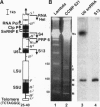Abstract
Chlorarachniophyte algae contain a complex, multi-membraned chloroplast derived from the endosymbiosis of a eukaryotic alga. The vestigial nucleus of the endosymbiont, called the nucleomorph, contains only three small linear chromosomes with a haploid genome size of 380 kb and is the smallest known eukaryotic genome. Nucleotide sequence data from a subtelomeric fragment of chromosome III were analyzed as a preliminary investigation of the coding capacity of this vestigial genome. Several housekeeping genes including U6 small nuclear RNA (snRNA), ribosomal proteins S4 and S13, a core protein of the spliceosome [small nuclear ribonucleoprotein (snRNP) E], and a cip-like protease (clpP) were identified. Expression of these genes was confirmed by combinations of Northern blot analysis, in situ hybridization, immunocytochemistry, and cDNA analysis. The protein-encoding genes are typically eukaryotic in overall structure and their messenger RNAs are polyadenylylated. A novel feature is the abundance of 18-, 19-, or 20-nucleotide introns; the smallest spliceosomal introns known. Two of the genes, U6 and S13, overlap while another two genes, snRNP E and clpP, are cotranscribed in a single mRNA. The overall gene organization is extraordinarily compact, making the nucleomorph a unique model for eukaryotic genomics.
Full text
PDF





Images in this article
Selected References
These references are in PubMed. This may not be the complete list of references from this article.
- Altschul S. F., Gish W., Miller W., Myers E. W., Lipman D. J. Basic local alignment search tool. J Mol Biol. 1990 Oct 5;215(3):403–410. doi: 10.1016/S0022-2836(05)80360-2. [DOI] [PubMed] [Google Scholar]
- Bhattacharya D., Helmchen T., Melkonian M. Molecular evolutionary analyses of nuclear-encoded small subunit ribosomal RNA identify an independent rhizopod lineage containing the Euglyphina and the Chlorarachniophyta. J Eukaryot Microbiol. 1995 Jan-Feb;42(1):65–69. doi: 10.1111/j.1550-7408.1995.tb01541.x. [DOI] [PubMed] [Google Scholar]
- Craik C. S., Rutter W. J., Fletterick R. Splice junctions: association with variation in protein structure. Science. 1983 Jun 10;220(4602):1125–1129. doi: 10.1126/science.6344214. [DOI] [PubMed] [Google Scholar]
- Doolittle W. F. The origins of introns. Curr Biol. 1991 Jun;1(3):145–146. doi: 10.1016/0960-9822(91)90214-h. [DOI] [PubMed] [Google Scholar]
- Gilson P., McFadden G. I. The chlorarachniophyte: a cell with two different nuclei and two different telomeres. Chromosoma. 1995 May;103(9):635–641. doi: 10.1007/BF00357690. [DOI] [PubMed] [Google Scholar]
- Gilson P., Waller R., McFadden G. Preliminary characterisation of chlorarachniophyte mitochondrial DNA. J Eukaryot Microbiol. 1995 Nov-Dec;42(6):696–701. doi: 10.1111/j.1550-7408.1995.tb01618.x. [DOI] [PubMed] [Google Scholar]
- Gish W., States D. J. Identification of protein coding regions by database similarity search. Nat Genet. 1993 Mar;3(3):266–272. doi: 10.1038/ng0393-266. [DOI] [PubMed] [Google Scholar]
- Gottesman S., Squires C., Pichersky E., Carrington M., Hobbs M., Mattick J. S., Dalrymple B., Kuramitsu H., Shiroza T., Foster T. Conservation of the regulatory subunit for the Clp ATP-dependent protease in prokaryotes and eukaryotes. Proc Natl Acad Sci U S A. 1990 May;87(9):3513–3517. doi: 10.1073/pnas.87.9.3513. [DOI] [PMC free article] [PubMed] [Google Scholar]
- Grivell L. A. Intron mobility. Invasive introns. Curr Biol. 1994 Feb 1;4(2):161–164. doi: 10.1016/s0960-9822(94)00039-4. [DOI] [PubMed] [Google Scholar]
- Huang C., Wang S., Chen L., Lemieux C., Otis C., Turmel M., Liu X. Q. The Chlamydomonas chloroplast clpP gene contains translated large insertion sequences and is essential for cell growth. Mol Gen Genet. 1994 Jul 25;244(2):151–159. doi: 10.1007/BF00283516. [DOI] [PubMed] [Google Scholar]
- Hurst L. D. Molecular evolution. The uncertain origin of introns. Nature. 1994 Sep 29;371(6496):381–382. doi: 10.1038/371381a0. [DOI] [PubMed] [Google Scholar]
- Kozak M. A consideration of alternative models for the initiation of translation in eukaryotes. Crit Rev Biochem Mol Biol. 1992;27(4-5):385–402. doi: 10.3109/10409239209082567. [DOI] [PubMed] [Google Scholar]
- Krainer A. R. Pre-mRNA splicing by complementation with purified human U1, U2, U4/U6 and U5 snRNPs. Nucleic Acids Res. 1988 Oct 25;16(20):9415–9429. doi: 10.1093/nar/16.20.9415. [DOI] [PMC free article] [PubMed] [Google Scholar]
- Marks J., Simanis V. Cloning of the gene for ribosomal protein S13 from the fission yeast Schizosaccharomyces pombe. Nucleic Acids Res. 1992 Aug 11;20(15):4094–4094. doi: 10.1093/nar/20.15.4094. [DOI] [PMC free article] [PubMed] [Google Scholar]
- McFadden G. I., Gilson P. R., Hofmann C. J., Adcock G. J., Maier U. G. Evidence that an amoeba acquired a chloroplast by retaining part of an engulfed eukaryotic alga. Proc Natl Acad Sci U S A. 1994 Apr 26;91(9):3690–3694. doi: 10.1073/pnas.91.9.3690. [DOI] [PMC free article] [PubMed] [Google Scholar]
- Merino E., Balbás P., Puente J. L., Bolívar F. Antisense overlapping open reading frames in genes from bacteria to humans. Nucleic Acids Res. 1994 May 25;22(10):1903–1908. doi: 10.1093/nar/22.10.1903. [DOI] [PMC free article] [PubMed] [Google Scholar]
- Palmer J. D., Logsdon J. M., Jr The recent origins of introns. Curr Opin Genet Dev. 1991 Dec;1(4):470–477. doi: 10.1016/s0959-437x(05)80194-7. [DOI] [PubMed] [Google Scholar]
- Roop D. R., Nordstrom J. L., Tsai S. Y., Tsai M. J., O'Malley B. W. Transcription of structural and intervening sequences in the ovalbumin gene and identification of potential ovalbumin mRNA precursors. Cell. 1978 Oct;15(2):671–685. doi: 10.1016/0092-8674(78)90035-1. [DOI] [PubMed] [Google Scholar]
- Russell C. B., Fraga D., Hinrichsen R. D. Extremely short 20-33 nucleotide introns are the standard length in Paramecium tetraurelia. Nucleic Acids Res. 1994 Apr 11;22(7):1221–1225. doi: 10.1093/nar/22.7.1221. [DOI] [PMC free article] [PubMed] [Google Scholar]
- Tittiger C., Whyard S., Walker V. K. A novel intron site in the triosephosphate isomerase gene from the mosquito Culex tarsalis. Nature. 1993 Feb 4;361(6411):470–472. doi: 10.1038/361470a0. [DOI] [PubMed] [Google Scholar]
- Wickens M. How the messenger got its tail: addition of poly(A) in the nucleus. Trends Biochem Sci. 1990 Jul;15(7):277–281. doi: 10.1016/0968-0004(90)90054-f. [DOI] [PubMed] [Google Scholar]
- Zorio D. A., Cheng N. N., Blumenthal T., Spieth J. Operons as a common form of chromosomal organization in C. elegans. Nature. 1994 Nov 17;372(6503):270–272. doi: 10.1038/372270a0. [DOI] [PubMed] [Google Scholar]




